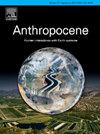代海500年沉积记录揭示的蓝藻群落对气候变化和人类活动的不同响应
IF 3.9
2区 地球科学
Q2 ENVIRONMENTAL SCIENCES
引用次数: 0
摘要
由于缺乏长期的生物多样性记录,湖泊微生物组合对气候变化和人类活动的不同响应尚未得到很好的了解。本研究采用古湖泊学和沉积古DNA宏基因组测序相结合的方法,研究了中国北方代海湖近500年来的环境变化、湖泊初级生产力和蓝藻群落演替。结果表明,在不同的时间尺度上,蓝藻群落对气候变化和人为活动的响应不同。在~ 1850 CE之前,湖泊初级生产力、生物多样性和营养状况基本处于自然状态,主要受温度和降水控制,但此后受到人类活动的明显影响。总体微生物多样性值在~ 1850 CE之后逐渐增加,排序分析进一步表明,目前的群落与~ 1850 CE之前观察到的有很大的不同。在~ 1850 CE之前,蓝藻群落结构相对稳定,随后出现明显的年代际波动,与沉积有机质分子组成大致同步。这些分子代用物表明,在过去的一个多世纪里,人为强迫而不是气候可能是蓝藻群落的主要控制因素。土地利用变化和农田径流加剧、工业废水和生活污水排放增加可能是导致湖泊初级生产力和蓝藻群落组成变化的主要因素。我们的发现强调了季风边缘区湖泊生态系统对人为干扰的敏感响应,适当的外源养分控制(如农业径流阈值)对于维持区域水生生态系统的可持续性是必要的。本文章由计算机程序翻译,如有差异,请以英文原文为准。
Different responses of cyanobacterial communities to climate change and anthropogenic activities revealed by the 500-year sedimentary record of Lake Daihai
Different responses of lake microbial assemblages to climate changes and human activities are not well understood due to the scarcity of long-term biodiversity records. In this study, an approach of paleolimnology and metagenomic sequencing of sedimentary ancient DNA was combinedly used to investigate environmental changes, lake primary productivity, and cyanobacterial community succession over the last ∼500 years in Lake Daihai, northern China. The results show a different response of cyanobacterial communities to climate change and anthropogenic activities on different timescales. Lake primary productivity, biodiversity, and trophic status were in a generally natural state and were mainly controlled by temperature and precipitation before ∼1850 CE, but were clearly affected by human activities thereafter. Overall microbial diversity values gradually increased after ∼1850 CE, and ordination analysis further indicates that the present community is substantially dissimilar to that observed before ∼1850 CE. The structure of cyanobacterial communities was relatively stable prior to ∼1850 CE, followed by prominent decadal scale fluctuations that were broadly synchronous with the sedimentary organic matter molecular compositions. These molecular proxies reveal that anthropogenic forcing, rather than climate, may be the primary controls of cyanobacterial communities over the past one more century. Enhanced land-use change and cropland runoff, and increased discharges of industrial wastewater and human sewage are likely the main factors driving changes in lake primary productivity and cyanobacterial community composition. Our finding highlights the sensitive responses of lake ecosystem to anthropogenic disturbance in the monsoon marginal zone, and proper exogenous nutrient control (e.g., thresholds for agricultural runoff) is necessary to maintain the sustainability of the regional aquatic ecosystems.
求助全文
通过发布文献求助,成功后即可免费获取论文全文。
去求助
来源期刊

Anthropocene
Earth and Planetary Sciences-Earth and Planetary Sciences (miscellaneous)
CiteScore
6.30
自引率
0.00%
发文量
27
审稿时长
102 days
期刊介绍:
Anthropocene is an interdisciplinary journal that publishes peer-reviewed works addressing the nature, scale, and extent of interactions that people have with Earth processes and systems. The scope of the journal includes the significance of human activities in altering Earth’s landscapes, oceans, the atmosphere, cryosphere, and ecosystems over a range of time and space scales - from global phenomena over geologic eras to single isolated events - including the linkages, couplings, and feedbacks among physical, chemical, and biological components of Earth systems. The journal also addresses how such alterations can have profound effects on, and implications for, human society. As the scale and pace of human interactions with Earth systems have intensified in recent decades, understanding human-induced alterations in the past and present is critical to our ability to anticipate, mitigate, and adapt to changes in the future. The journal aims to provide a venue to focus research findings, discussions, and debates toward advancing predictive understanding of human interactions with Earth systems - one of the grand challenges of our time.
 求助内容:
求助内容: 应助结果提醒方式:
应助结果提醒方式:


